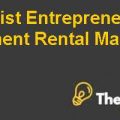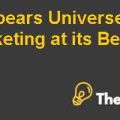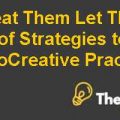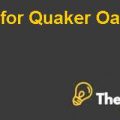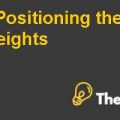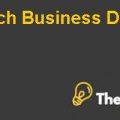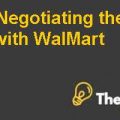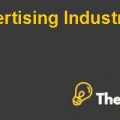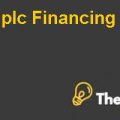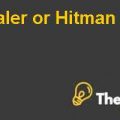If Berkshire bids for Carter’s, given your estimate of asset value, should they use Goldman’s step-on financing package? If so, give an estimate of the cost of debt for the Carter’s purchase.
If the company is 100% equity financed then it is acceptable to have some debt and in this case the value of the company is $893.9 million and the offered debt is $360 million that represents around 40% of the total value of the company. This structure represents 60% equity and 40% debt financing (Simon S P Lee, 2015).
In the last scenario, the cost of equity is 13.24% and the cost of equity is based on 100% equity financed as the debt is injected the cost of equity increases due to increase in the risk that a shareholder takes in the case of debt financing. In case of default, debt holders are paid first and then the remaining amount is paid to the shareholders therefore the risk is increased and the higher risk come up with a higher expected return for the cost of equity needs to be revised.
The revised cost of equity is also calculated through the same CAPM formula, but in this case the beta equity has changed and the new beta equity is 1.42 (appendix). The revision is made on the basis of the new capital structure that is specified above. The revised beta equity has changed the cost of equity and the new cost of equity is 17.02% (appendix)(CAPM, 2015).
The cost of debt is less than that cost of equity and cost of equity does not give any tax benefit to the company. The tax benefit reduces the cost of debt and the current net cost of debts of all three finances is 5.11% for revolver, 5.64% for term loan B and 7.61% for subordinated debts (Appendix)(Bins bergen, 2015).
The overall return has increased as the new weighted average cost of capital is 12.79% that is below than 13.24% with 100% equity finance. The cost of equity has increased, but the decrease in cost of equity has made the returns favorable for the shareholders that are the ultimate owners of the company. The total extra saving to its shareholders is $56.15 million because of debt financing (Appendix)(Pren hall, 2015).
The cost of debt for first two is based upon the LIB OR rate of interest that is variable and can fluctuate in the future. The upward fluctuations can push the WACC with debt financing to increase more than 13.24% and the downward movement can increase the saving for the shareholders.
What IRR does you forecast on the investment, assuming Berkshire buys Carter’s for your estimate and it uses the Goldman financing package? Does this exceed the cost of capital for the deal?
The IRR for the investment after taking some assumptions is 18% (appendix) that is above 12.79%.
The first assumption is that it has acquired Carter at the price $893.9 million and it has also exercised the option of financing from Goldman Sachs (GS). The rate is positive in the current terms and it may not be possible for the company to maintain this rate in the future years.
The debt financing is used for the short period and it is based on the variant i.e. LIB OR and a change in this variable does change the IRR. The purchase price changes can also change the IRR. The risk free rate of interest and the market risk premium can also change the IRR as the required return changes does change IRR.
IRR is acceptable for valuation model, but the most appropriate model is free cash flow. The acquisition is acceptable with both valuation models as it is above WACC and NPV is positive by above $56 million.
Recommendation:
It is recommended to go for debt financing offered from Goldman Sachs (GS), as if it has any other option that seems better, then it should accept any other alternative which can be debt financing from banks. The financing from SG has some loans that are short term like 5 years, 7 years and 10 years, therefore it must know the repayment arrangement annually. The annual payments reduce the cash inflows and it can make it negative therefore the annual repayment must be considered. The exit strategy can be applied when the company is performing well and it is estimated that a higher price can be offered by any other company or partnership. At the time of profits and growth, the company can be sold at higher profits.
The bid price must be lower than $893.9 million because it is the maximum price and it must not depend upon the debt financing as the debt financing is not certain as even it is certain than it must take the advantage of that debt arrangement. The offer price must be such that it is acceptable and the company can pay higher than that if it has reasonable estimates to believe that it can sell Carter in the future with the higher price than that it pays along with its returns.
Appendix:
| Fore casted Financial Data and Ratios, adapted from case Exhibit 7a (in thousands of dollars and percent) | |||||||
| Assume | 2001E | 2002P | 2003P | 2004P | 2005P | 2006P | |
| Net Sales | 537,300 | 618,800 | 711,600 | 817,300 | 938,800 | 985,740 | |
| % growth | 13.8% | 15.2% | 15.0% | 14.9% | 14.9% | 5.0% | |
| Management | 13.8% | 15.2% | 15.0% | 14.9% | 14.9% | 5.0% | |
| Gross Profit | 221,900 | 260,900 | 302,400 | 348,300 | 400,400 | 420,420 | |
| margin | 41.3% | 42.2% | 42.5% | 42.6% | 42.7% | 42.7% | |
| Management | 41.3% | 42.2% | 42.5% | 42.6% | 42.7% | 42.7% | |
| SG&A | 146,800 | 172,200 | 193,300 | 214,100 | 238,800 | 250,740 | |
| % of sales | 27.3% | 27.8% | 27.2% | 26.2% | 25.4% | 25.4% | |
| Management | 27.3% | 27.8% | 27.2% | 26.2% | 25.4% | 25.4% | |
| EBITDA | 75,100 | 88,700 | 109,100 | 134,200 | 161,600 | 169,680 | |
| % of sales | 14.0% | 14.3% | 15.3% | 16.4% | 17.2% | 17.2% | |
| Depreciation | 20,000 | 21,100 | 21,800 | 24,400 | 28,100 | 29,505 | |
| EBIT | 55,100 | 67,600 | 87,300 | 109,800 | 133,500 | 140,175 | |
| % of sales | 10.3% | 10.9% | 12.3% | 13.4% | 14.2% | 14.2% | |
| Capex | 20,500 | 19,500 | 21,000 | 21,500 | 22,500 | 22,500 | |
| % of sales | 3.8% | 3.2% | 3.0% | 2.6% | 2.4% | 2.3% | |
| Management | 3.8% | 3.2% | 3.0% | 2.6% | 2.4% | 2.3% | |
| Source: Adapted from Malcolm P. Baker and James Quinn, "Berkshire Partners: Bidding for Carters", | |||||||
| HBS no. 205-058 (Boston: Harvard Business Publishing, 2005, 2008), Exhibit 7a, page 12. | |||||||
| 2001E | 2002P | 2003P | 2004P | 2005P | 2006P | Growth | |
| EBITDA | 75,100 | 88,700 | 109,100 | 134,200 | 161,600 | 169,680 | |
| Capital investment | 20,500 | 19,500 | 21,000 | 21,500 | 22,500 | 22,500 | |
| Working capital (5% of incremental sales) | 7,414.74 | 1,124.70 | 168.67 | 25.05 | 3.72 | 0.19 | |
| Tax (30% of EBIT) | 16,530.0 | 20,280.0 | 26,190.0 | 32,940.0 | 40,050.0 | 42,052.5 | |
| Free Cash flows | 30,655.26 | 47,795.30 | 61,741.33 | 79,734.95 | 99,046.28 | 105,127.31 | |
| Terminal Value | 1339908.88 | 5% | |||||
| Total free cash flows | 30,655.26 | 47,795.30 | 61,741.33 | 79,734.95 | 99,046.28 | 1,445,036.19 | |
| WACC | 13.24% | ||||||
| Present value of free cash flows | $893,919.06 | ||||||
| New WACC | 2001E | 2002P | 2003P | 2004P | 2005P | 2006P | Growth |
| EBITDA | 75,100 | 88,700 | 109,100 | 134,200 | 161,600 | 169,680 | 0 |
| Capital investment | 20,500 | 19,500 | 21,000 | 21,500 | 22,500 | 22,500 | 0 |
| Working capital (5% of incremental sales) | 7,414.74 | 1,124.70 | 168.67 | 25.05 | 3.72 | 0.19 | 0 |
| Tax (30% of EBIT) | 16,530.0 | 20,280.0 | 26,190.0 | 32,940.0 | 40,050.0 | 42,052.5 | 0 |
| Free Cash flows | 30,655.26 | 47,795.30 | 61,741.33 | 79,734.95 | 99,046.28 | 105,127.31 | - |
| Terminal Value | 1416251.278 | 5% | |||||
| Total free cash flows | 30,655.26 | 47,795.30 | 61,741.33 | 79,734.95 | 99,046.28 | 1,521,378.59 | 0 |
| WACC | 12.79% | ||||||
| Present value of free cash flows | $950,069.73 | 0 | |||||
| Bid price | $893,919.06 | ||||||
| Benefit to shareholders | $56,150.67 | ||||||
| IRR | |||||||
| free cash flows | 30,655.26 | 47,795.30 | 61,741.33 | 79,734.95 | 99,046.28 | 1,521,378.59 | |
| Price | ($893,919.06) | ||||||
| Net free cash flows | ($863,263.80) | $47,795.30 | $61,741.33 | $79,734.95 | $99,046.28 | $1,521,378.59 | |
| IRR | 18% | ||||||
| Selected Data on Public Companies Comparable to Carter's (in millions of dollars except where noted) | |||||||||||||||
| Company Business Description | Stock Price June 13, 2001 |
P/E Ratio 2001E |
P/E Ratio 2002E |
Earnings Growth Rate | IPO Date | Revenue | EBIT | EBITDA | Interest- Bearing Debt |
Market Capitalization | 5-Year Average Leverage |
Net Income | Beta equity | Beta Asset | |
| Nike | Designs, develops, and markets athletic and recreational footwear and apparel and sells a line of athletic performance equipment | $41.35 | 19.20 | 15.8x | 15% | 1980 | 9,488.8 | 1,014.2 | 1,211.6 | 1,296.6 | 7,224.3 | 8.4% | 589.7 | 1 | 0.888388 |
| Jones Apparel | Designs, markets, and wholesales its own branded apparel, footwear, and accessories; also licenses and markets branded costume jewelry, women's footwear, and apparel | $40.90 | 13.70 | 12.0x | 17% | 1991 | 4,115.3 | 645.9 | 757.3 | 1,482.1 | 5,343.6 | 17.1% | 327.6 | 1.1 | 0.9211559 |
| Tommy Hilfiger | Designs, sources, and markets men's and women's active/sportswear and jeans, accessories, footwear, fragrances, and home furnishings | $13.65 | 9.00 | 7.9x | 10% | 1992 | 1,836.7 | 194.6 | 302.1 | 567.0 | 1,245.7 | 18.1% | 130.2 | 1.3 | 0.9858821 |
| Liz Claiborne | Designs and markets a portfolio of retail-based and department store-based brands with consumer franchises. | $24.92 | 12.30 | 10.9x | 12% | 1981 | 3,186.7 | 333.4 | 417.9 | 519.6 | 2,650.2 | 4.4% | 184.6 | 1.2 | 1.0551839 |
| 13.55 | 0.9626525 | ||||||||||||||
| Source: | Adapted from Malcolm Baker and James Quinn, "Berkshire Partners: Bidding for Carter's", HBS no. 205-058 (Boston: Harvard Business Press, 2005, 2008), Exhibit 8, p. 14; business descriptions adapted from Thomson ONE Banker, accessed January 2011. | ||||||||||||||
| Selected Data on Transactions Comparable to Carter's (in millions of dollars over the previous 12 months except where noted) | |||||||||
| Target Name | Target Business Description | Acquirer Name | Value of Transaction | Target: Revenues | EBIT | EBITDA | Pretax Income | Net Income | Transaction Date |
| Too Inc | Manufacturers and retails girls' clothing | Financial buyers | 581.1 | 376.9 | 28.5 | 39.0 | 28.5 | 17.1 | 24-Aug-99 |
| McNaughton Apparel Group | Manufactures and wholesales women's clothing | Jones Apparel Group | 565.4 | 521.9 | 67.6 | 80.3 | 43.5 | 25.7 | 19-Jun-01 |
| Unitog Co | Manufactures, wholesales, and supplies uniforms | Cintas Corp | 370.8 | 275.2 | 25.3 | 42.7 | 20.2 | 12.5 | 24-Mar-99 |
| Donna Karan International | Manufactures women's and men's clothing | LVMH SA | 247.2 | 662.9 | 23.3 | 28.7 | 20.8 | 18.4 | 27-Nov-01 |
| Koret of CA (Levi Strauss) | Manufactures women's suits | Kellwood Co | 141.6 | 295.4 | 11.2 | 15.4 | 5.0 | 2.3 | 29-Apr-99 |
| Happy Kids Inc | Manufactures and wholesales children's clothing | HIG Capital LLC | 119.6 | 170.1 | 19.9 | 20.4 | 18.6 | 9.1 | 17-Dec-99 |
| Source: | SDC, accessed January 2011. | ||||||||
| Cost of equity (ke) | ||||
| P/E average | 13.55 | |||
| Average return | 13.55% | |||
| Risk free | 5.20% | |||
| market risk premium | 8.35% | |||
| Cost of equity (ke) | 13.24% | |||
| Cost of equity (new) | ||||
| Beta equity | 1.417023009 | |||
| Cost of equity | 17.03% | |||
| Cost of debt and equity | Amount | Required return | Tax free rate | Weightages |
| LIBOR | 4.30% | |||
| Revolver | 60.00 | 7.300% | 5.11% | 7% |
| Term loan B | 125 | 8.0500% | 5.64% | 14% |
| Subordinated debt | 175 | 10.88% | 7.61% | 20% |
| Equity | 533.90 | 17.03% | 17.03% | 60% |
| Total value | 893.9 | |||
| 12.79% |
This is just a sample partical work. Please place the order on the website to get your own originally done case solution.

